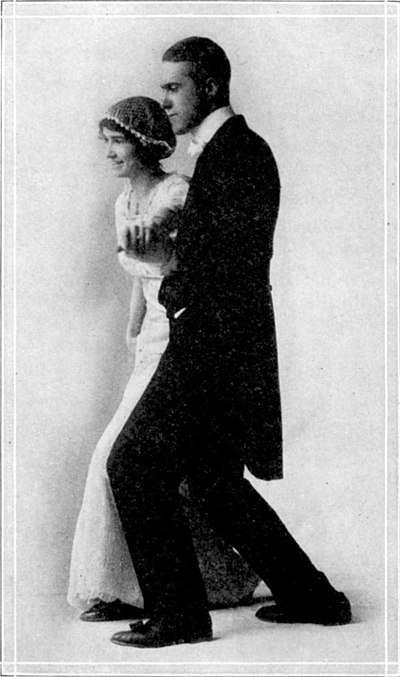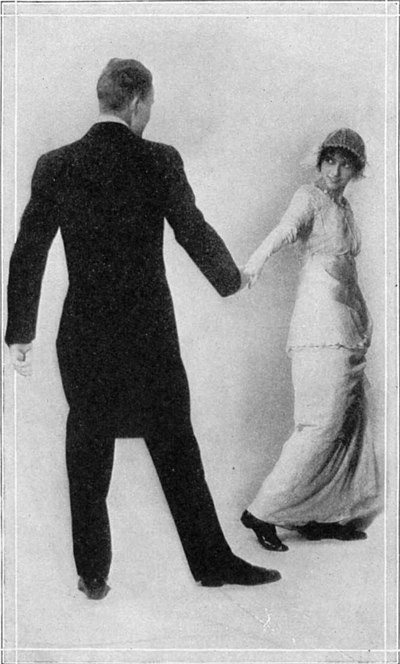The Modern Dances/Chapter 3
The Tango, or One Step
Many incorrect words and phrases have come, by common usage, to be recognized as correct, just as slang words have been converted into good English by the same process.
This is true of the Tango. What has been taught and danced for the past two or three seasons, and is still being danced as the Tango, is, in reality, not the Tango, but has been classified by the best authorities as the One Step.
The real Tango is a South American folk dance. It is a slow, stately dance, done to four-four time—not ragtime. Its many figures are for the most part difficult, both of description and accomplishment, but it is nevertheless becoming exceedingly popular for ball-room dancing.
I therefore bow to common usage and teach the One Step as the Tango, because it is the dance which the majority of people recognize as the Tango.
The real Tango, as taught on page 59, is distinguished by the caption "Argentine Tango."
The First Four Figures
The Tango cannot be danced to march or two-step music. Ragtime airs, such as "Too Much Mustard," "The Robert E. Lee," "Melinda's Wedding Day" and a score of other popular songs of the day, written in 2-4 or 4-4 time and played rapidly, are especially adapted to this dance.
I advise as little practice as possible without music. Try the steps with this book in your hand just long enough to get the idea, then practice them to music, for the inspiration of the ragtime airs is the greatest help in learning.
Figure 1. Four Steps Forward and Back
Position, as shown in Illustration 1.
The Man
The Lady
Starting with the right foot, take four slow, running, slightly springy steps backward and the same forward. These steps should be made in a slow, easy run, barely lifting the feet from the floor.
Figure 2. Circling
Position, as shown in Illustration 1.
Circling consists simply in turning completely around, letting the feet follow the body naturally.
The Man
Swing the right foot around backward, the left around forward, the right backward again and the left forward—four steps to complete the Circle. Repeat this Circle before starting the next figure.
The Lady
Figure 3. The Grape Vine
Position, as shown in Illustration 1.
The Man
¶ 1.One full step backward with the right foot, swinging it over enough to stop on a line behind the left foot.
¶ 2.A short step straight to the side with the left foot.
¶ 3.A full forward swing with the right foot, stopping it in front of and on a line with the left foot.
¶ 4.A short step to the side with the left foot.
¶ 5.A full backward swing with the right foot, stopping it on a line behind the left foot.
¶ 6.A short step to the side with the left foot.
¶ 7.Same as in ¶ 3, and so on, repeating as above. Sixteen steps constitute the complete Grape Vine.
Remember that the right foot only goes forward and back. The left foot moves only to the side, taking you on a straight line across the room. As in the Forward and Back Steps, both the Circle and Grape Vine are the same slow, running, slightly springy steps, barely lifting the feet from the floor.
The Lady
¶ 1.One full step forward with the left foot, swinging it over enough to stop on a line in front of the right foot.
¶ 2.A short step straight to the side with the right foot.
¶ 3.A full backward swing with the left foot, stopping it behind and on a line with the right foot.
¶ 4.A short step to the side with the right foot.
¶ 5.A full forward swing with the left foot, stopping it on a line in front of the right foot.
¶ 6.A short step to the side with the right foot.
¶ 7.Same as in ¶ 3, and so on, repeating as above. Sixteen steps constitute the complete Grape Vine.
Remember that the left foot only goes forward and back. The right foot moves only to the side, taking you on a straight line across the room. As in the Forward and Back figure, both the Circle and the Grape Vine are the same slow, running, slightly springy steps, barely lifting the feet from the floor.
Figure 4. The Draw
This is about the simplest and, to the onlooker, is the most attractive of the four figures.
Position, as shown in Illustration 1.
The Man
Starting with the left foot, take one step directly to the side; then, keeping the right foot on the floor, draw it up until the heel touches the left. Repeat this three times more. To avoid stiffness in this figure, as you draw the right foot up, turn the body slightly to the right with just the suggestion of a dip. See Illustration 2.
The Lady
Starting with the right foot, take one step directly to the side; then, keeping the left foot on the floor, draw it up until the heel touches the right. Repeat this three times more. To avoid stiffness in this figure, as you draw the left foot up, turn the body slightly to the left with just the suggestion of a dip. See Illustration 2.
This completes the four fundamental Tango figures, which should be made in the following order: Four Steps Forward and Back, Circle twice, Grape Vine, Circle twice, Draw, Circle twice and then repeat.Don't get the idea that the Tango is difficult. It is not. It is the simplest dance imaginable and is consequently easy of accomplishment. These four figures, as was said before, constitute the dance, and when they are mastered the rest is easy.
In the following pages I give many of the other figures, but I would advise learning the first four thoroughly before attempting the others. Other Tango Figures
Assuming that the beginner has become thoroughly familiar with the first four figures of the Tango, those following are described with less attention to detail. They are not described for the man and the lady separately, but for the man, as he leads. The lady will understand, of course, that the man's left means her right, the man's backward means her forward, and so on.
Any new figure should be started after Circling as it is easier then to change steps or position.
Changes of position should be made without stopping, losing a step or getting out of time to the music.
THE CRISS-CROSS
Position, as shown in Illustration 3.
The man's right arm is passed behind the lady, holding her right hand in his right, which rests lightly on her right hip.
¶ 1. Both starting with the left foot, take four running steps forward; on the fifth step change position, the man crossing over behind the lady without releasing the hands or losing a step. Three more steps forward and cross back again. In other words this is merely twelve steps forward, changes of position being made on the fifth and ninth steps. Completion of these
¶ 2. Now, without losing a step or getting out of time to the music, both take one step straight to the left with the left foot. Then backward with the right foot and dip. (See Illustration 4.) Again sideways with the left foot, backward with the right and dip, and so on for ten or twelve steps, keeping on a straight line to the left.
¶ 3. Repeat ¶ 1.
¶ 4. Keeping the same position as in Illustration 3, do the Grape Vine, dipping on the backward step. This is the same Grape Vine as shown on page 16, except that you dip on the backward step and your partner is at your side instead of in front.
THE FOUR-STEP GRAPE VINE
Position, as shown in Illustration 1.
The man starts forward with his left foot and the lady backward with her right, taking four steps; then make a quarter turn and go backward four steps; then another quarter turn and four steps backward, continuing these steps until you have crossed the floor.
THE GRAPE VINE DIP
Position, as shown in Illustration 1.
This is the Grape Vine as described on page 16, with the addition of the dip on the man's backward step and the lady's forward.
THE SHUFFLE
Position, as shown in Illustration 5.
Take six running steps forward. Then the man and the lady each turn completely around and take six steps in the opposite direction, the lady being on the man's left arm and the man on the lady's right.
Be sure to keep the free arm out to the side as shown in the illustration, so that, in turning, it falls easily around the partner.
THE LAME DUCK
This is a very popular figure. When you see it done you will appreciate the name.
Position, as shown in Illustration 1, excepting that the dancers slightly separate, still clasping hands and face forward. (See illustration 6.)
The man starts forward with his right foot and the lady with her left, dipping as they take the next step. The dip is made by the man bending his right knee and the lady her left.
Repeat this figure straight down the room.
ANOTHER TANGO START
Position, as shown in Illustration 1, except that the couple slightly separates, still clasping hands and faces forward. (See Illustration 6.)
The man with his left foot and the lady with her right start forward together, taking four steps; then the Circle, the Grape Vine, etc.
This will be found to be an exceedingly graceful way to start the Tango.
SIMPLE FIGURES
These and the other figures may be continued at the pleasure of the dancers, as there is no fixed rule as to the order of the figures or the number of times they should be taken.
Position, as shown in Illustration 7.
Both start forward with the left foot, taking four steps, then swing a quarter turn around, taking four steps backward—then another quarter turn and four steps forward.
Repeating this figure will take one in a zig-zag fashion across the floor, at right angles.
Position, as shown in Illustration 1.
The man starts with his left foot and the lady with her right; the man taking three steps forward and the lady backward; on the third step
It will be found that by emphasizing the "tap" zest is lent to this figure.
Position, as shown in Illustration 8.
Each pull the other forward and release the hands, continuing forward four steps, passing each other to the left. Return backward four steps, passing each other to the right, then one step forward into position, as shown in Illustration 1.
The lady takes her right hand from the man's left and places it behind her into the man's right hand. She then makes a complete backward circle, which brings her at arm's length from the man. See Illustration 9. Then she circles forward and they resume the original position.
Another attractive figure is made by the lady, keeping her right hand in the man's left, circling twice under his outstretched arm, the man meanwhile taking sidewise steps. Come back to original position and dip once.











